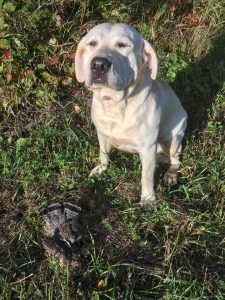By Nick Simonson
Going from hunting sharptailed grouse on the plains to ruffed grouse in the woods often presents several changes and challenges. Beyond the distances traveled, the walking required, adjusting of chokes and the solitary nature of the birds, the most notable test is finding one’s way around in the towering and varied stands of trees. Where just a few days prior, covering a stretch for the prairie species was as easy as looking up to the unblocked horizon and following my dog’s nose to a flushing covey of sharpies. While I’ve never done the research, or even checked on my own to see if ruffies and other upland birds like sharptails or pheasants smell alike, I can always rely my dog’s heightened sense of smell uninfluenced by the arboreal environs to find the birds and turn to my GPS to locate the next turn in the trail or the way back to the truck.
 Ole, my yellow lab, now one-and-a-half, plows through the undergrowth of the northern forest as easily as if he were parting the soft grasses of the plains. His block-granite physique is more mastiff than retriever as the woods bend to his thundering will while my hunting buddies and I walk along the winding paths mowed recently by the state or county crews. Still predominantly green at this early point in the season, the aspens and maples occasionally show hints of color which drop to the ground as the dog rumbles through the lower story vegetation.
Ole, my yellow lab, now one-and-a-half, plows through the undergrowth of the northern forest as easily as if he were parting the soft grasses of the plains. His block-granite physique is more mastiff than retriever as the woods bend to his thundering will while my hunting buddies and I walk along the winding paths mowed recently by the state or county crews. Still predominantly green at this early point in the season, the aspens and maples occasionally show hints of color which drop to the ground as the dog rumbles through the lower story vegetation.
To match the commotion, his nose booms audibly as he sucks up the scentlines of the hard-to-spot ruffed grouse scattered throughout the woods. With surprising ease and little prodding, he takes to the wooded territory off to either the side of the trail, and I watch as he winds his way into the brush and disappears from sight. The cracking of branches and crackling of leaves stops in the distance and I whistle. The cacophony resumes as he bounds back, jumping over deadfalls and smashing his way through saplings. It’s a different world, but still, undoubtedly his, and that’s just when he goes in to inspect. When the occasional scent trail of a wandering grouse crosses our path, no deadfall is unjumpable, no alder patch is unpartable, and his pursuit is undeniable. Behind the pumping machine of nostrils and olfactory cells, the blonde engine powers the genetically developed biotechnology relentlessly into the woods and inevitably toward a distant whir of frantically beating wings that launch off into the forest.
In the dim conditions under a canopy of old pines, Ole begins to switch back and forth, winding around the sap-covered trunks of the trees. It’s the traditional prairie behavior of a dog on scent, now easily seen in the gray light of the open area into which I follow the chase. Needles, debris and detritus spray from his back paws with each on-a-dime turn as Ole winds his way to the north end of the woods, and I ready my gun as flushing wings pound for the edge and a quick escape.
A thunderous beat draws him closer and another bird takes to the sky. He closes the gap and a third bird lifts, banging and bouncing through the blue-green boughs that form the boundary of the pine stand. Eyeing the silhouette of the forest grouse, I let loose both barrels on my 20-gauge and watch the bird tumble into the grasses just beyond the edge of the woods along the marshy edge of the alder swamp. In the final walk of our time in the northern forest, our first and only ruffie of the trip – an immature female – gets tucked into my vest, a newly minted memory which will be easier to locate than the bird in environs that provided it…in our outdoors.
